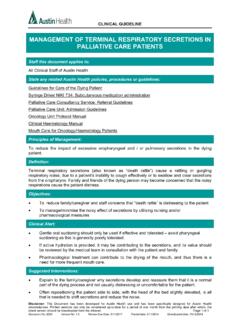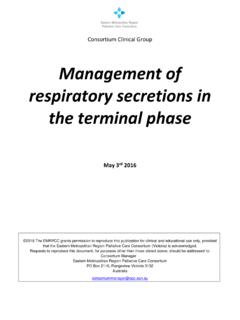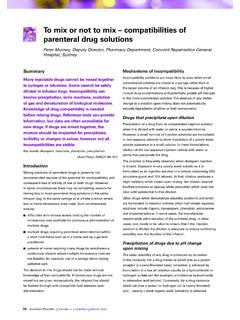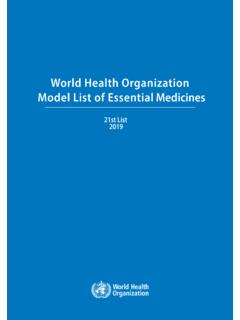Transcription of Hyoscine Hydrobromide Scopoderm PIL - Scottish Palliative …
1 Scottish Palliative care Guidelines Hyoscine Hydrobromide ( Scopoderm ) Page 1 of 2 Copyright 2020 NHS Scotland Issue Date: 03/06/2020 Patient Information Leaflet Hyoscine Hydrobromide Transdermal Patch for Respiratory Secretions ( Scopoderm ) Name of the medicine: Hyoscine Hydrobromide Transdermal Patch for respiratory secretions ( Scopoderm ) (Each patch delivers 1mg of Hyoscine over 72 hours) What is it for? Hyoscine Hydrobromide belongs to a group of medicines called anti-cholinergics . These medicines help to prevent the formation of secretions that can cause problems in your respiratory tract. Your respiratory tract is the part of your body involved with breathing. The secretions can build up if you are unable to clear your own throat and can cause noisy breathing. This can be distressing. A patch can be a useful way of giving a medicine when you are unable to swallow or when it is not possible to give the medicine by another route, for example by injection.
2 Most medicines available in the UK have a licence for use. The licence describes the ways in which the medicine can be given and the conditions it can be used to treat. In order to get a licence, the manufacturer of the medicine has to show that it is safe and made to a high standard. The use of Hyoscine Hydrobromide patches for respiratory secretions is outside its licence. Medicines used in Palliative care are quite often used this way. There is experience and research to support the use of Hyoscine Hydrobromide in this way. The person who prescribed your medicine will have considered carefully the benefits for you. Information on this is not included in the information leaflet supplied with the medicine. We are giving you this extra leaflet to tell you about the reason(s) why you are taking this medicine and to highlight other information. This should be read along with the manufacturer s patient information leaflet.
3 What form(s) of this medicine are there and how is it usually taken? Hyoscine Hydrobromide Transdermal Patch is applied to the area of thin skin behind your ear. The patch is applied and left in place for 3 days (72 hours). The medicine is absorbed through your skin and into your bloodstream. If necessary, further patches may be applied to achieve the desired effect as advised by your doctor or other health professional. Sometimes the patches can be cut in half to give a smaller dose. After 72 hours, the patch(es) should be removed and replaced. The leaflet supplied with the patches contains instructions and pictures to help you. Scottish Palliative care Guidelines Hyoscine Hydrobromide ( Scopoderm ) Page 2 of 2 Copyright 2020 NHS Scotland Issue Date: 03/06/2020 What are the most common side effects I might experience? Hyoscine Hydrobromide can also dry up other secretions in your body.
4 You may experience a dry mouth or dry and gritty eyes. Other side effects may include: blurred vision confusion agitation dizziness excessive drowsiness difficulty in passing patch may also irritate the area of skin it is applied to. What other information should I know about this medicine? Hyoscine Hydrobromide will help to prevent the formation of respiratory secretions but will not have any effect on secretions which have already formed. Wash your hands after handling the patches to prevent transferring Hyoscine to your eyes. Your medication needs to be kept in a safe place out of the reach of children. It needs to be stored in the original container. Return unused medication to a pharmacy. Any other important information? As well as taking medicines, changing how you are sitting or lying down can sometimes help. To prevent having an uncomfortable dry mouth, regular mouth care should be carried out.
5 You should clean your teeth at least twice a day. Regular sips or sprays of water or artificial saliva preparations can be used. Your lips should also be moistened. Dry eyes may be relieved by using lubricating eye drops, ointment or gels. Please ask your pharmacist for advice.

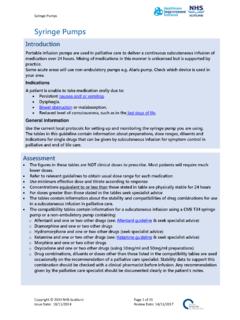


![[P] Dexamethasone - Palliative Care](/cache/preview/1/a/e/e/2/6/4/f/thumb-1aee264f75f950080ac53b4a77b63f09.jpg)
